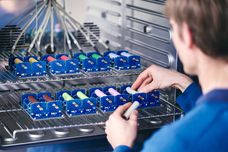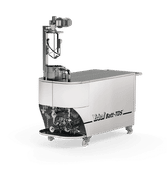Completely stretchy lithium-ion battery for flexible electronics
This new way of creating fully stretchable, solid batteries could be a promising step forward for wearable or implantable devices that flex and move with the body
Advertisement
When you think of a battery, you probably don’t think stretchy. But batteries will need this shape-shifting quality to be incorporated into flexible electronics, which are gaining traction for wearable health monitors. Now, researchers in ACS Energy Letters report a lithium-ion battery with entirely stretchable components, including an electrolyte layer that can expand by 5000%, and it retains its charge storage capacity after nearly 70 charge/discharge cycles.

This lithium-ion battery has entirely stretchable components and stable charging and discharging capacity over time.
Adapted from ACS Energy Letters 2024, DOI: 10.1021/acsenergylett.4c01254
Electronics that bend and stretch need batteries with similar properties. Most researchers who have attempted to build such batteries created them with woven conductive fabric or rigid components folded into expandable shapes, similar to origami. But for a truly malleable battery, every part — the electrodes that collect charge and the charge-balancing middle electrolyte layer — must be elastic. So far, truly stretchy battery prototypes have moderate elasticity, complex assembly processes or limited energy storage capacity, especially over time with repeated charging and discharging. The latter can be due to a weak connection between the electrolyte layer and electrodes or instability of the fluid electrolyte, which can move around when the battery changes shape. So, rather than using a liquid, Wen-Yong Lai and coworkers wanted to incorporate the electrolyte into a polymer layer fused between two flexible electrode films, to create a completely solid, stretchy battery.
To make the electrodes for the fully elastic battery, the team spread a thin film of conductive paste containing silver nanowires, carbon black and lithium-based cathode or anode materials onto a plate. A layer of polydimethylsiloxane, a flexible material commonly used in contact lenses, was then applied to the top of the paste. Directly on top of this film, the researchers added a lithium salt, a highly conductive liquid and the ingredients to make a stretchy polymer. When activated by light, these components combined to form a solid, rubbery layer capable of stretching to 5000% of its original length and able to transport lithium ions. Finally, the stack was topped with another electrode film, and the whole device was sealed in a protective coating.
When comparing the solid stretchy battery design to a similar device with a traditional liquid electrolyte, the new version had about six times higher average charge capacity at a fast-charging rate. Likewise, the solid battery maintained a more stable capacity while operating during 67 charging and discharging cycles. In other prototypes made with solid electrodes, the polymer electrolyte maintained steady operation over 1000 cycles, with capacity dropping by 1% in the first 30 cycles, compared to a 16% drop for the liquid electrolyte. There are still improvements to be made, but this new way of creating fully stretchable, solid batteries could be a promising step forward for wearable or implantable devices that flex and move with the body.
Original publication
Other news from the department science
These products might interest you
Most read news
More news from our other portals
See the theme worlds for related content
Topic World Battery Technology
The topic world Battery Technology combines relevant knowledge in a unique way. Here you will find everything about suppliers and their products, webinars, white papers, catalogs and brochures.

Topic World Battery Technology
The topic world Battery Technology combines relevant knowledge in a unique way. Here you will find everything about suppliers and their products, webinars, white papers, catalogs and brochures.































































